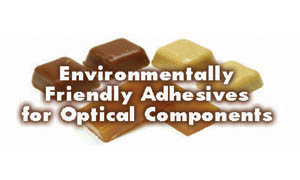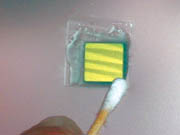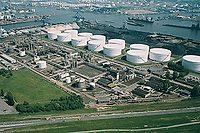
Several years ago, Horizon Photonics Inc. was struggling with labor costs and product quality in its dicing operations. The then California-based producer of optical components and technologies* noticed that it was spending an inordinate amount of time cleaning the dicing adhesive from its optical components. “An operator had to inspect each tiny optic under a stereoscope and clean them all individually, so it was quite a bottleneck in our process,” says Matt DeRemer, process engineer. “Additionally, our optics are laminated, and the acetone we used for cleaning and debonding was also attacking the adhesive we used for lamination.”
The main problem was the adhesive used to hold the products in place during the dicing and machining operations. Although the adhesive worked well and had a sufficient amount of bond strength, harsh chemicals and lengthy processing steps were required to remove the adhesive from the components after the dicing and machining operations were complete. Additionally, the company had to carefully control the use, storage and disposal of these chemicals to ensure employee safety and avoid violating any Occupational Safety and Health Administration (OSHA) or Environmental Protection Agency (EPA) regulations.
“We were throwing a lot of time and money into the cleaning process, and that was digging into our profit margin and holding us back from taking on new product orders,” explains DeRemer. “We knew we had to find a solution.”

A Water-Soluble Alternative
In Camarillo, CA, a chemist and a project engineer had recognized this problem in the mid-’90s and began developing an alternative. Their research led to the introduction of a new water-soluble thermoplastic adhesive, called AquaBond—and a new company, AquaBond Technologies—in 1998.“The company’s founders realized that ceramic and glass manufacturers were looking for a way to temporarily bond products so that when they debond them, they don’t have to introduce them to a hot isopropyl alcohol (IPA), methyl ethyl ketone (MEK) or acetone bath. The chemist decided to try to rearrange the molecules of conventional adhesives so that the adhesives could be debonded with hot water—and he was successful,” explains Tim Pyle, who is now the owner and president of AquaBond Technologies.
According to Pyle, some companies use wax—which can also debond in hot water—to hold their products in place. However, the wax must still be filtered out of the water through an additional processing step. The water-soluble thermoplastic adhesives, on the other hand, dissolve completely in hot water, leaving nothing behind.
“When you put them in hot water, they literally dissolve and disappear—no additional processing steps are needed. You don’t have to worry about wastewater treatment unless the workpiece itself is hazardous—for example, if you’re using exotic materials that contain beryllium. But if your material is simple silicon or another non-hazardous material, the water used for cleaning can just go down the drain,” Pyle says.
The ability to use water as the debonding agent also provides a number of other benefits. For example, companies no longer have to be concerned about chemical interactions between the cleaning solution and their products. Additionally, because the adhesive itself is very environmentally friendly, companies can use it to bond even sensitive products, such as semiconductor wafers. And it is also less expensive than many conventional adhesives.
“It doesn’t go any farther, but it weighs a little bit less per stick. And when you don’t have to buy the supporting chemicals for debonding, or hire additional personnel to oversee the use and disposal of those chemicals, the water-soluble adhesive becomes very economical,” Pyle explains.
To further enhance the debonding process, the company also developed an environmentally friendly cleaner, called AquaClean 900. “It’s like cleaning dirty dishes—you can use hot water or cold water, but hot water is better, and using hot water with surfactant is ideal,” Pyle says. “AquaClean 900 is also an environmentally safe product and completely disappears in the water. It’s not necessary, but it does speed the debonding and cleaning process. In fact, some companies that don’t even use AquaBond have chosen to use AquaClean as a post-process cleaner because it works so well.”

Proven Benefits
DeRemer began searching for an aqueous-dissolvable product and immediately stumbled upon AquaBond. After two weeks of intensive testing to ensure that the product met the company’s bond strength requirements and didn’t cause any adverse chemical interactions, DeRemer decided to switch to the new adhesive. (He also decided to use the recommended cleaner.) Within weeks Horizon Photonics began experiencing significant benefits.“With the water-soluble adhesive, we no longer have to clean each piece individually. Instead, we’ve been able to automate the process by running multiple pieces through the cleaning solution in a tape application,” DeRemer explains. “This has enabled us to cut both our cleaning costs and our cleaning time by 50%, or even more for some products. For instance, a single wafer that was cut up into little pieces used to take about five hours to clean with our old adhesive; now that same wafer only requires about an hour for cleaning as it goes through the automated process.”
The time and cost savings has also enabled Horizon Photonics to provide a faster turnaround time and lower prices on its products. Additionally, the company’s customers appreciate the environmentally friendly aspect of the water-soluble adhesive. “Customers often want to know what kind of chemicals we’re using on their optics. When we give them the Materials Safety Data Sheet, they can see that there are no chemicals that could possibly react with their product.”
In today’s difficult manufacturing environment, these advantages have become especially important. “Using the water-soluble adhesive has allowed us to keep our existing customer base by making us more competitive. It has decreased our time to market and increased our profit margin, and it has allowed us to pass those savings along to our customers. It’s really been a win-win situation across the board. If we hadn’t switched to the water-soluble adhesive, our manufacturing output would have been severely crippled,” DeRemer says.
Future Potential
According to Pyle, the water-soluble thermoplastic adhesives can be used in just about any temporary glass or ceramic bonding application. Companies are also discovering that it can be used in other applications. For instance, one manufacturer has discovered that the adhesive can be successfully used as an encapsulant material.“There are a lot of opportunities for this product if you’re a good process engineer who is able to adapt and think out of the box. You can do things with this material that other people haven’t even though of. And because it’s so environmentally friendly, you know it’s not going to ‘attack’ the final workpiece,” Pyle says.
AquaBond Technologies is also working to develop a new cleaner with a lower pH level than its existing cleaner. “AquaClean 900 has a pH of 10-11, which is pretty strong, so it won’t work with all products. We discovered that there is a need for a pH-neutral cleaner, so we’ve been working on that and hope to be able to introduce a new environmentally friendly cleaner by the end of 2003," Pyle says.
References:
*The company recently moved its headquarters to Orlando, FL.For more information:
For more information about the water-soluble thermoplastic adhesives or environmentally friendly cleaners, contact AquaBond Technologies, 5235 Mission Oaks Blvd., #300, Camarillo, CA 93012; (866) 270-1104 or (805) 383-4008; fax (805) 383-4018; e-mailinfo@aquabondtechnologies.com;or visithttp://www.aquabondtechnologies.com.

